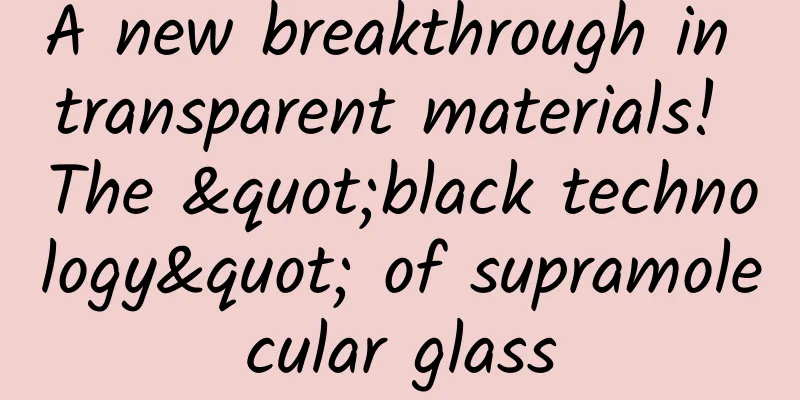A new breakthrough in transparent materials! The "black technology" of supramolecular glass

|
Produced by: Science Popularization China Author: Shi Wuyao (PhD in Biology) Producer: China Science Expo Editor's note: In order to understand the latest developments in cutting-edge science and technology, the China Science Popularization Frontier Science Project has launched a series of articles titled "Understanding Top Science Journals", which selects outstanding papers from authoritative journals and interprets them in plain language as soon as possible. Let us broaden our scientific horizons and enjoy the fun of science through the window of top journals. In our daily lives, transparent materials are everywhere, from smartphone screens to windows of high-rise buildings, and they bring us endless convenience with their unique transparency and functionality. Scientists are also exploring a new transparent material - supramolecular glass, which may lead a new round of revolution in the field of transparent materials. So, what exactly is supramolecular glass? What are its unique advantages? Next, let us step into the world of supramolecular glass and explore this new chapter of future transparent materials. Transparent windows (Photo source: veer photo gallery) On April 19, 2024, Chinese scientists published an article on the preparation of supramolecular glass in the journal Nature Communications, announcing the development of highly transparent supramolecular glass, which provides a new idea for the construction of transparent materials in the future! The research results were published in the journal Nature Communications (Image source: Nature Communications) What is supramolecular glass? Supramolecular glass, a name that sounds rather mysterious, is actually an amorphous material formed by non-covalent cross-linking. Compared with traditional inorganic and organic glasses, supramolecular glass has attracted much attention for its unique intrinsic structural characteristics and excellent optical properties. It is not only a transparent material, but also a material that is recyclable, has good compatibility and thermal processability. These characteristics make supramolecular glass have a wide range of application prospects in industrial production, scientific research and daily life. However, the research on supramolecular glass is still in its infancy. Glass (Photo source: veer photo gallery) Preparation of supramolecular glass Scientists used the solvent evaporation method to synthesize supramolecular glass using methyl-β-cyclodextrin and p-hydroxybenzoic acid as raw materials. The synthesis process is mainly divided into two key steps: First, under high temperature conditions, the water molecules in the mixture of methyl-β-cyclodextrin and p-hydroxybenzoic acid aqueous solution are removed by evaporation. Methyl-β-cyclodextrin is used as the host molecule and p-hydroxybenzoic acid is used as the guest molecule to form a new supramolecular polymer through host-guest recognition. Secondly, the polymer is hot-pressed at a temperature and pressure of 80°C and 20MPa for 10 minutes, and finally a transparent, bulk supramolecular glass is constructed. Since there are multiple host-guest unit recognition modes between the two substances of the synthetic raw materials, the structure of the final supramolecular glass is also diverse. Preparation process of supramolecular glass (Image source: Reference 1) Properties of supramolecular glass Scientists have conducted a series of characterizations on the properties of the prepared supramolecular glass. The results show that the synthesized supramolecular glass is colorless and transparent. Under the irradiation of 300 to 1000nm wide wavelength light, the transparency of the supramolecular glass exceeds 85%, which is comparable to the transparency of transparent glass materials sold on the market. However, when the supramolecular glass is dried under vacuum, it becomes an opaque material with a visible light transmittance of less than 10%. Scientists further characterized the supramolecular glass by combining atomic force microscopy, surface area measurement, stretching and load-bearing experiments. The results showed that the prepared supramolecular glass has a dense, non-porous structure with good stability and mechanical strength. A thickness of 2 mm can withstand a weight of 200 g without breaking. Properties of supramolecular glass (a, photo of supramolecular glass; b, transmittance of supramolecular glass and dry glass; c, photo of dry glass; de, atomic force characterization; f, reduced modulus and hardness of supramolecular glass and dry glass; g, load test; h, tensile stress-strain curve; i, tensile stress of supramolecular glass changing with time at room temperature and 30% humidity) (Image source: Reference 1) In addition to its excellent transparency and mechanical strength, supramolecular glass can also be recycled! After the supramolecular glass is cut into pieces, it is ground into small particles at the micron level. These small particles are dissolved into a solution, and the water in the solution is heated and evaporated again. The resulting crude product is hot-pressed to prepare new supramolecular glass. After repeating the preparation process five times, the transparency of the glass finally obtained will not decrease compared to the first glass. In addition, scientists added a series of inorganic and organic compounds such as silver nitrate, copper sulfate, and ferric chloride to the glass, and the prepared glass still maintained good transparency and mechanical strength. Supramolecular glass has good chemical compatibility with these added substances. Based on this property, in subsequent research, scientists can modify supramolecular glass to expand the scope of application of supramolecular glass. Recyclability and compatibility testing of supramolecular glass (a, glass recycling; b, transparency of recycled glass; c, e, glass after adding different chemicals; f, transparency of glass after adding different chemicals; g, reduced modulus and hardness of glass after adding different chemicals) (Image source: Reference 1) Conclusion Supramolecular glass, as a new star in the field of materials science, has a wide range of application prospects in many fields due to its unique properties and excellent performance. However, the research and application of supramolecular glass still faces many challenges, from the optimization of preparation process to the improvement of performance, from cost control to environmental protection considerations. We believe that with the advancement of technology and in-depth research, supramolecular glass will bring us more surprises and breakthroughs. Let us look forward to the glorious future of supramolecular glass! References: 1.Cai, C., Wu, S., Zhang, Y. et al. Bulk transparent supramolecular glass enabled by host–guest molecular recognition. Nat Commun 15, 3929 (2024). 2.Nie, F., Wang, KZ. & Yan, D. Supramolecular glasses with color-tunable circularly polarized afterglow through evaporation-induced self-assembly of chiral metal–organic complexes. Nat Commun 14, 1654 (2023). 3. Wu Shenjiang, Zhang Wenbin, Cao Yan, et al. Research on stress distribution uniformity detection technology of block transparent materials[J]. Automation and Instrumentation, 2022(000-001). 4. Wang Yanxing, Yang Penghui, Li Xianzi, et al. Research progress of high temperature resistant transparent materials[J]. Functional Materials, 2022, 53(10):10054-10061. |
<<: Does exercising have to last more than 30 minutes to lose weight? 29 minutes won’t do?
Recommend
Woman’s cell phone number leaked: How much for one night?
Since November 27, Ms. Zhang, a resident of Jiyua...
Qualcomm + Huawei: Snapdragon 810 reaches 410Mbps!
Qualcomm announced today that it has successfully...
Magic Leap finally officially announced its first headset! Can $2 billion plus six years of research and development rebuild market confidence in AR?
Finally, Magic Leap, an augmented reality startup...
"Pure" pornographic video sites are also beginning to learn to flirt
In the past few years, major video websites have ...
Top 10 Brand Keywords in 2019 and 5 Trends in 2020
Today, let’s summarize and review the 10 key word...
Event Operation: How to plan a complete event? (Attached with mind map)
The planning document is clearly well-written, bu...
He wrote three articles to promote the formulation of China's first "Seed Law" | Museum Exploration Notes
Editor’s Note: On May 30, the Chinese Scientists ...
Community marketing case: How to operate WeChat community well?
I believe many people still remember the battle a...
In addition to "swan meat", toads also favor swans, dead fish, and even your rain boots?
There is a saying that goes "A toad wants to...
Apple to try adding mental health features to iPhone
Apple is working on a series of new programs to h...
National Day Special: 30 pictures to see the "stunning beauty" of China!
On the land of China The blue color of water and ...
After grains and vegetables, can we also “ask for food from the forest”?
The autumn breeze brings the fragrance of fruits ...
Velcro antibiotics are here! Hug bacteria before killing them?
Produced by: Science Popularization China Author:...
Why do non-smokers also get lung cancer?
According to the World Cancer Report 2020 release...
Talk about the three methods of gaining users through paid social networks
In recent years, various paid communities are sti...



![Kotlin has become the new darling of Android after waking up [with code]](/upload/images/67ebd9aa1a69b.webp)





